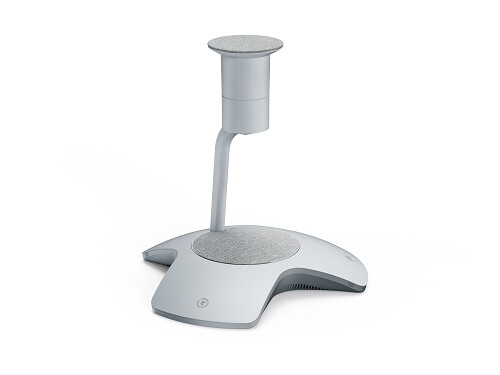



































£895.00*
- Resolution 1920 x 1080 Full HD
- Field of view 360°


Frequently purchased together
Product information
Yealink SmartVision 60 is a new generation of all-in-one audio and video device jointly developed by Yealink and Microsoft for smart conference rooms. SmartVision 60 has a 360° wide field of view with a 360° audio capture range, enabling a comprehensive and immersive conferencing experience. A 10k camera makes every position in the medium-sized boardroom clearly visible. And the 6m wide sound reception area covers every corner of the room. The Yealink SmartVision 60 is equipped with a host of innovative audio and video AI features from Microsoft to give you a breakthrough audio and video experience. With the Multi-Stream People Feed feature, meeting participants get their own individual frame in the gallery to make remote participants feel closer to the people in the room. The Yealink SmartVision 60 also includes all the great features of Microsoft Teams smart speakers, including People Recognition in Live Transcription and Cortana digital assistant. The SmartVision 60 has a flip-up privacy screen with a ring of LED lights that automatically flips up and down in sync with meeting status to protect your privacy.
All-in-one audio & video device
Yealink SmartVision 60 upholds the concept of integrated design; it is a new generation of 360° all-in-one smart camera; it integrates camera, microphone and speaker to achieve that a single device can meet all the needs of a medium-sized meeting room.
360° 10K panoramic wide-angle camera
No hidden participants. More inclusive meetings.

With 360° coverage and centre table perspective, no one in the room will be out of sight. The brand new 10K camera delivers stunning images with much more detail in every detail too. Remote participants can now have a more complete meeting experience even when they are not present.
Multiple Intelligent Functionalities

The Yealink SmartVision 60 is equipped with a host of the latest AI features from Microsoft: The Multi-Stream People Feed feature gives meeting participants their own individual frame in the gallery to make remote participants feel closer to the people in the room. The Cortana intelligent voice assistant can easily unlock meeting voice control, the intelligent voice transcription feature enables unmanned meeting minutes mode with just one click, the real-time intelligent translation feature and online real-time subtitle translation can enable a new experience of accessible communication between multiple participants, and intelligent participant identification provides a unique, personalised meeting experience.
Intelligent voice assistant and transcription
Freehanded meetings with Cortana
Make sure everyone is heard
With two sets of multifunctional microphones, the SmartVision 60 - the intelligent 360° all-in-one conference camera for meeting rooms - easily covers a 20-foot (6 m) radius for audio capture from all angles in medium-sized rooms and also supports intelligent audio features.
Technical data
| Name | Yealink SmartVision 60 Conference Camera, 1920 x 1080 Full HD, 360° |
|---|---|
| Article number | 1000029067 |
| GTIN/EAN | 6938818315150 |
| Manufacturer SKU | SmartVision 60 |
| Model name | SmartVision 60 |
| Brand | Yealink |
| Product Type | Conference Camera |
| Resolution | 1920 x 1080 Full HD |
| Focus type | Manual & automatic focus |
| Digital Zoom | 5 |
| Field of view | 360° |
| Inputs | 1x USB-C |
| Weight | 3.2 kg |
| Colour | Silver |
| Condition | New |
| Warranty | 24 Month |
| Warranty type | Bringin service Service and support information |
Product safety
| Person responsible for the EU |
|---|
| ALSO Deutschland GmbH |
| Ernst-Heinkel-Str. 4 |
| 94315 Straubing |
| Germany |
| sales@yealink.com |




